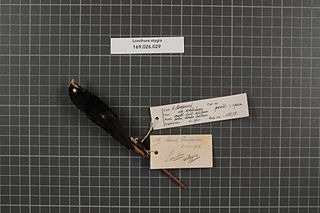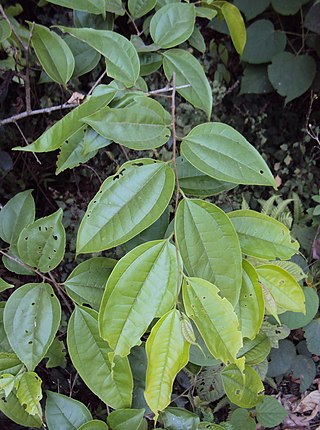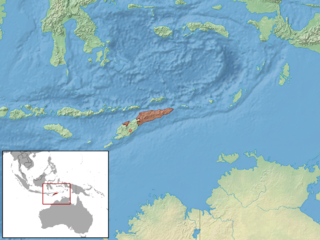
The Javan rusa or Sunda sambar is a large deer species native to Indonesia and East Timor. Introduced populations exist in a wide variety of locations in the Southern Hemisphere.

The guitarfish, also referred to as shovelnose rays, are a family, Rhinobatidae, of rays. The guitarfish are known for an elongated body with a flattened head and trunk and small, ray-like wings. The combined range of the various species is tropical, subtropical, and warm temperate waters worldwide.

The savanna nightjar, sometimes also allied nightjar or Franklin's nightjar, is a species of nightjar found in South and Southeast Asia. Six subspecies are recognised: C. a. monticolus, C. a. amoyensis, C. a. stictomus, C. a. affinis, C. a. timorensis and C. a. propinquus. It was once considered conspecific with the chirruping nightjar. The IUCN Red List has assessed the species to be of least concern because it has a large range and its population trend is stable.

Varanus timorensis, the Timor monitor or spotted tree monitor, is a species of small monitor lizards native to the island of Timor and some adjacent islands.

The black mannikin or black munia is a species of estrildid finch found in New Guinea, from Mandum to Lake Daviumbu, Papua New Guinea. It is commonly found in flocks of maximum 20 birds, inhabiting savannas, wetlands, but sometimes they were also seen at rice crops.
The Timor rat is a species of rodent in the family Muridae found in Indonesian West Timor, where it lives in the teak forests. It is known from a specimen collected near the summit of Mount Mutis.
Mammea timorensis is a species of flowering plant in the Calophyllaceae family. It is found only in Indonesia.

The black-banded flycatcher, also known as the Timor flycatcher, is a species of bird in the family Muscicapidae. In the past the species was considered to be related to the Australasian robins but this was as the result of convergent evolution. It is endemic to Timor island. The black-banded flycatcher is small with a broad bill and distinctive plumage. The species has a white belly, lower rump and throat with a thin black band across the chest. The tail, neck and wings are black and the back, upper wing and shoulders rich chestnut. The plumage of the head is sexually dichromatic, with the head being black in the males and dark grey in the females. The eye and bill is black and the feet and legs are yellow. The calls consist of soft whistles, some of which sound similar to the Timor stubtail.

Aptychotrema is a genus of guitarfish, belonging to the family Rhinobatidae. They are found around Australia.

The southern shovelnose ray, western shovelnose ray, or yellow shovelnose ray is a species of fish in the Rhinobatidae family. It is endemic to southern Australia. Its natural habitats are open seas and shallow seas.

The eastern shovelnose ray is a species of guitarfish in the family Rhinobatidae of order Rhinopristiformes. The species is endemic to the east coast of Australia and inhabits subtropical and temperate waters from southern Queensland to southern New South Wales.

The Kimberley rock monitor is a medium-sized species of monitor lizard in the family Varanidae. The species is native to Northern Australia. Also known commonly as Glauert's monitor and the Kakadu sand goanna, it belongs to the subgenus Odatria.

Celtis timorensis, commonly known as stinkwood or stinking wood, is a species of flowering plant in the family Cannabaceae that grows in tropical Asia. The specific epithet comes from the name of the island of Timor, the locality of the type collection. The most notable characteristic of the tree is the strong excrement odour that it emits from the bark and sap, which pervades the surrounding forest. This is due to the presence of the malodorous organic compound skatole. In Thailand, it therefore known as kæ̂ng k̄hī̂ phrar̀wng or mị̂ chĕd tūd phrar̀wng which means 'wipe the bottom timber'. Thai legend has it that Phra Ruang wiped his buttocks with it. In Sri Lanka the heartwood of the tree is used as a traditional ayurvedic medicine against syphilis, chickenpox, and measles.

The Pacific emerald dove or brown-capped emerald dove is a pigeon which is a widespread resident breeding bird in the tropical and sub-tropical parts of Indonesia to northern and eastern Australia. It was formerly conspecific with the common emerald dove.
Oxera balansae is a New Caledonian flowering plant in the mint family (Lamiaceae). It was first formally named in 1906. Little is known about its population size; it is known from scattered locations on Grande Terre, Pine Island, and Lifou. It is listed as an Endangered species on the IUCN Red List due to its limited distribution and habitat loss and degradation by agriculture, rusa deer, and uncontrolled fires.

Trygonorrhinidae, the banjo rays, is a family of rays, comprising eight species in three genera. They were formerly classified in the family Rhinobatidae.

Eremiascincus timorensis is a species of skink found in Timor in Indonesia.
Halichoeres timorensis, the Timor wrasse, is a species of salt water wrasse found in the Indo-West Pacific Ocean.
This page is based on this
Wikipedia article Text is available under the
CC BY-SA 4.0 license; additional terms may apply.
Images, videos and audio are available under their respective licenses.














